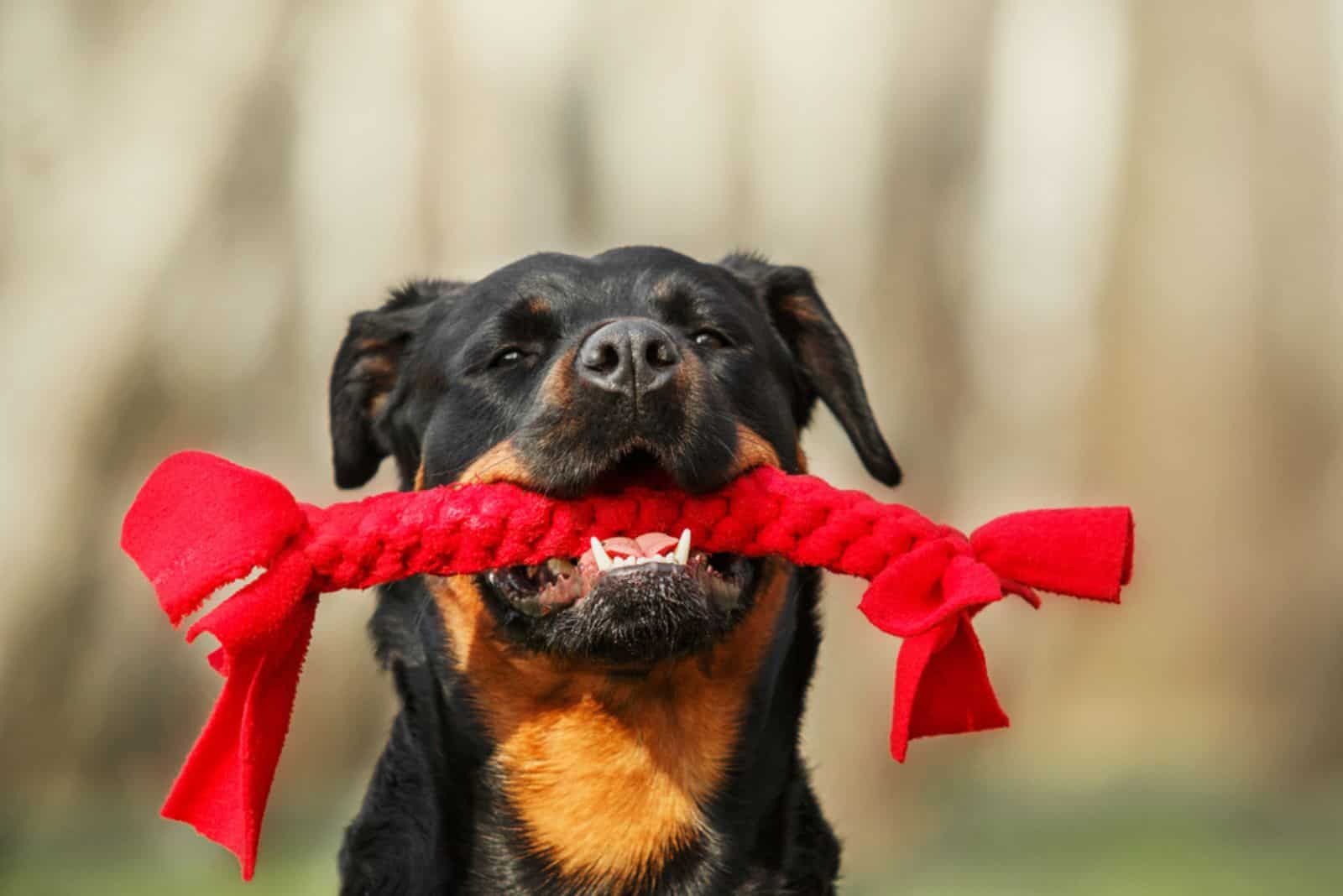There are plenty of breeds that have an immense palette of colors available for potential dog owners. Still, certain breeders like to cater to dog lovers with “extravagant” and never seen coat colors on dog breeds that never had it in their gene pool.
Such is the case with the red Rottweiler. Getting a red Rottie is not going to be easy, and for a good reason. Many aspects of breeding Rottweilers to produce a red litter are questionable, to put it nicely.
Today, we are going to talk about why a red Rottweiler is not only a rarity but a planned deviation from the well-established breed standard and how there is much more in it than an unusual coat color.
The Inception Of The Red Rottweiler Color
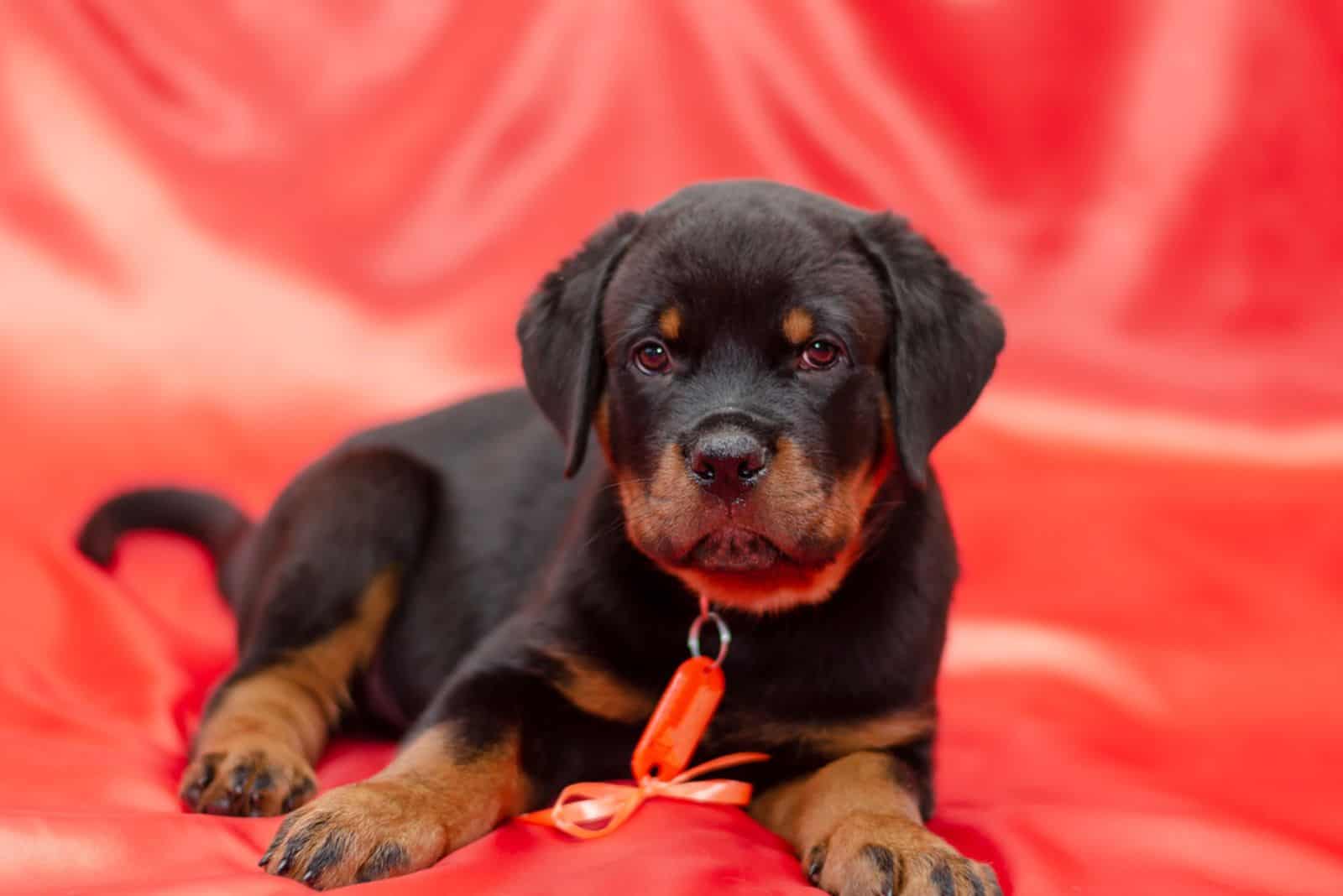
While spontaneous genetic mutations are a possibility in dogs, this particular color in the rottweiler is not common at all. A red coat in a Rottweiler can be achieved only by selective breeding, inbreeding, or crossbreeding.
Canine genetics are the determining factor in controlling coat, eye, and nose color. Two types of pigment participate in the creation of coat colors, patterns, and markings. One of them is called eumelanin, and the other one is phaeomelanin.
Eumelanin, the black pigment, is responsible for producing a black or brown-colored coat. Under the influence of different alleles from specific loci (a location on the gene), it can be diluted or transformed into another color, such as blue or liver.
Phaeomelanin, on the other hand, is a red pigment that is responsible for producing various shades of that color on a dog’s coat, ranging from yellow to deep red, like in the Irish Setter.
The MC1R gene controls the eumelanin and phaeomelanin production levels. If two alleles (gene variations) of the same type are on the E locus, the production of eumelanin will be inhibited, making the red pigment mask any other color, exactly like in a red Rottweiler.
What Is A Red Rottweiler Puppy Exactly?
The inhibited production of eumelanin leads to a coat color that is of a particular shade of red, such as the one found on red Rottweilers. Since both dog parents must have this recessive gene, a purebred red Rottweiler indicates that its parents had a spontaneous genetic pigment mutation.
Breeding two dogs with melanin mutations is considered unethical due to the health problems such abnormalities carry with them. This is why a unique-colored Rottweiler is probably a result of inbreeding or poor selective breeding.
Another way to get a red Rottweiler is to breed a standard-colored dog with another breed. This means it is not a purebred dog but a hybrid dog that inherited most of its physical features from the Rottweiler breed, while the coat color is from the other parent breed.
Breeders that practice crossbreeding usually mix Mastiffs with Rottweilers, so make sure you are aware of all the Mastiff breeds that can be part of the mix. Since both dog breeds are of German origin and have similar temperaments and some physical features, this mix is not that rare.
This is why you will not find reputable breeders who sell red Rottweilers. “Rare Rottweilers“ are mostly produced by backyard breeders who focus on exclusivity, which in turn appeals to potential dog owners who want their Rottweiler dog to be the most special one.
Breeding red Rotties is a red flag that you should not ignore. Either it was unethically bred, or it is a hybrid dog. Either way, this will only expose the breeder’s shady side.
Red Color In Rottweilers Comes From The E Locus
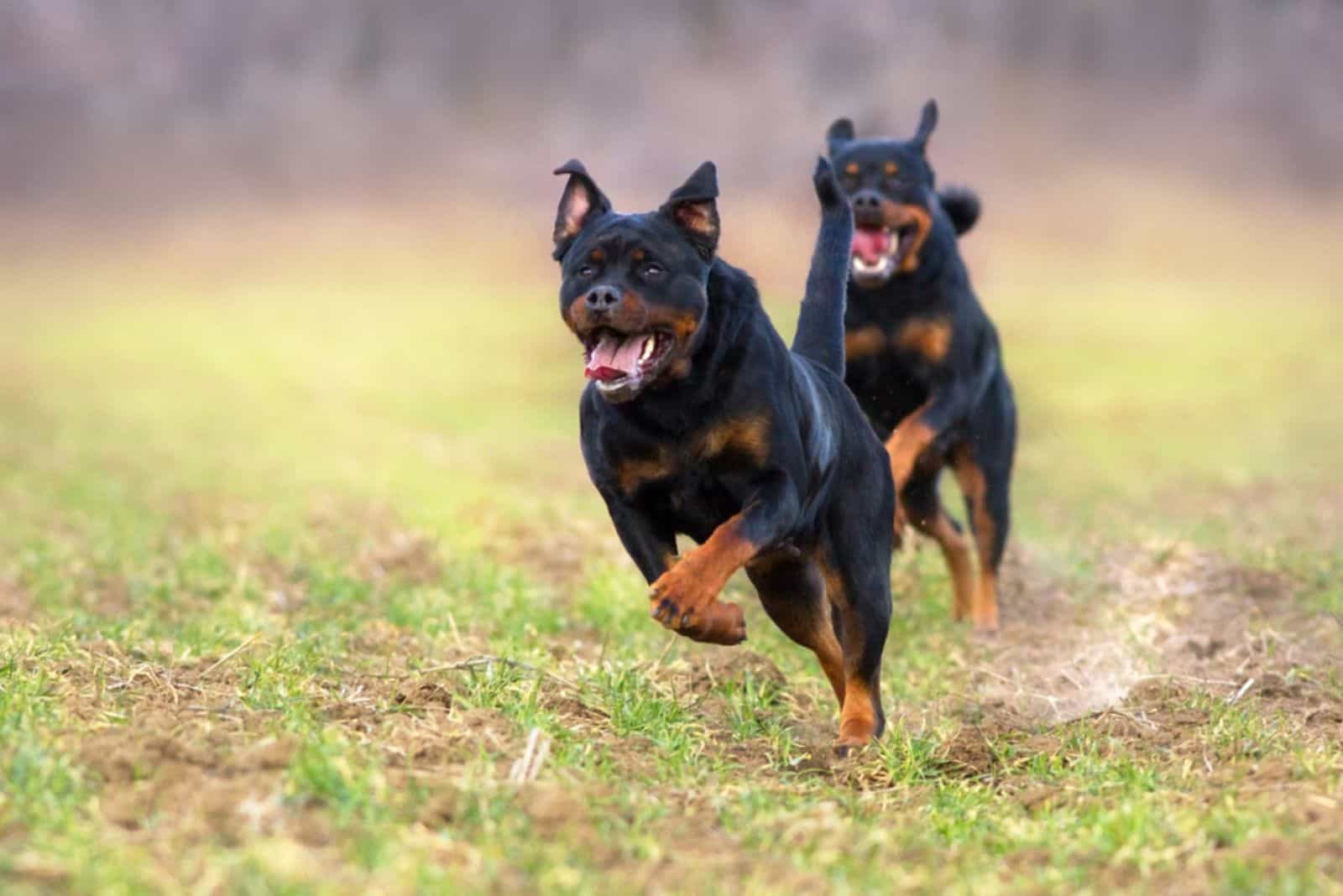
While both eumelanin and phaeomelanin contribute to dog coat colors, the latter only affects the coat without influencing the eye, nose, and paw pigmentation. Eumelanin on the A locus (agouti) controls color patterns and combinations, but the MC1R gene can have a recessive allele.
This recessive allele can be found in two forms and only on the E locus (extension). A pair of dominant E alleles will make the dog’s coat black. In this case, both Rottweiler parents pass on the E allele to their offspring.
When a recessive e allele is paired with the dominant E allele, the result will depend on how the E locus interacts with loci A, K, and B. The A locus is responsible for color variations, patterns, and markings, the K allele is the dominant black, while the B allele controls brown coloring.
A Rottie with a pair of recessive alleles on loci K, B, and E will have test results that say N/N for the K locus, b/b for the B locus, and e/e for the E locus, but the A locus results will be irrelevant since the recessive E and K loci mask the agouti locus.
This means that a Red Rottweiler must have two recessive genes on the E locus for its coat to be red. The combination of b/b on the B locus will give the nose a brown coloring instead of black and a light brown (amber) eye color.
For a Rottie to have a red coat, both parents must have the recessive gene, though they do not have to express it. If one allele on the E locus is dominant (E) and the other is recessive (e), the recessive one will be passed on to fifty percent of the litter.
Breeding a Rottweiler without a red coat that carries the recessive gene to another Rottweiler with the recessive gene will most likely result in seventy-five percent of the litter being red. If both parents have the recessive gene on the E locus will produce a one hundred percent red litter.
What Is The Rarest Rottweiler Color?
Red Rotties are extremely rare. However, finding an albino Rottweiler is next to impossible. Because this is a genetic mutation characterized by the absence or low production of melanin, an albino Rottweiler is not white but colorless.
White in a dog’s coat is always an absence of color and not a solid. Albinism is very rare, and dogs with this disorder often have eyes of a pale color or, most frequently, red. Breeding dogs with albinism is not ethical, as it almost guarantees the puppy will have a hereditary disease.
What Is The Physical Appearance And Temperament Of A Red Rottweiler?
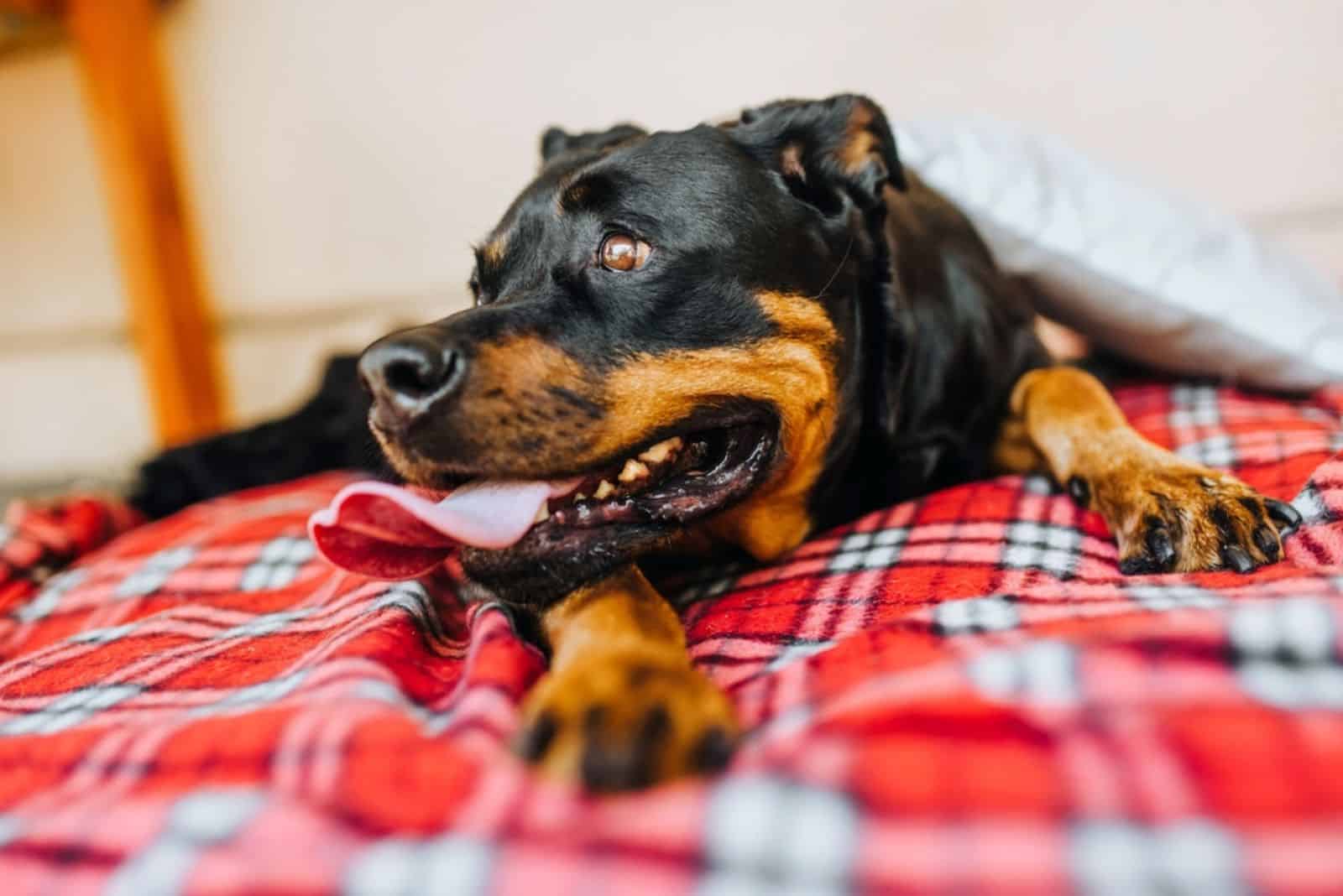
If a red Rottie is not the product of crossbreeding, it will have the same physical traits as any other purebred Rottweiler. A large-sized, muscular dog with a square frame but sporting a red coat is still a Rottweiler.
In terms of temperament, we are, again, looking at the same Rottweiler. Courageous, loyal, and protective, the red Rottie will be a great companion for any family looking for a watchdog. Here is a detailed explanation of a red Rottie’s looks and mind.
Physical Appearance
A male Rottweiler should be between twenty-four and twenty-seven inches tall and weigh between ninety-five and one hundred thirty-five pounds. Females are slightly smaller at twenty-two to twenty-five inches tall, with a weight ranging from eighty to one hundred pounds.
The body frame is square, but the body length slightly exceeds the height. A wide skull that sets the hanging ears apart has to match the body proportions. The stop is clearly defined, with a medium-length wide muzzle that does not narrow towards the nose.
Rottweiler eyes should be shaped like almonds and of a dark brown color. The brow bone is slightly pronounced. A thick and muscular neck balances the head-to-body proportion and connects to muscular shoulders that continue into a broad, deeply set chest.
A straight back ends in a tail of medium length, with the position ruling over length. A docked tail should be cut at the second vertebra and, if left undocked, appear as an extension of the body frame.
The bone structure must be thick to follow the muscular body but without arching legs. The loin is neatly tucked but not pronounced. In terms of coat quality, a short, smooth coat is the breed standard, with an undercoat of gray, black, or tan color.
Temperament
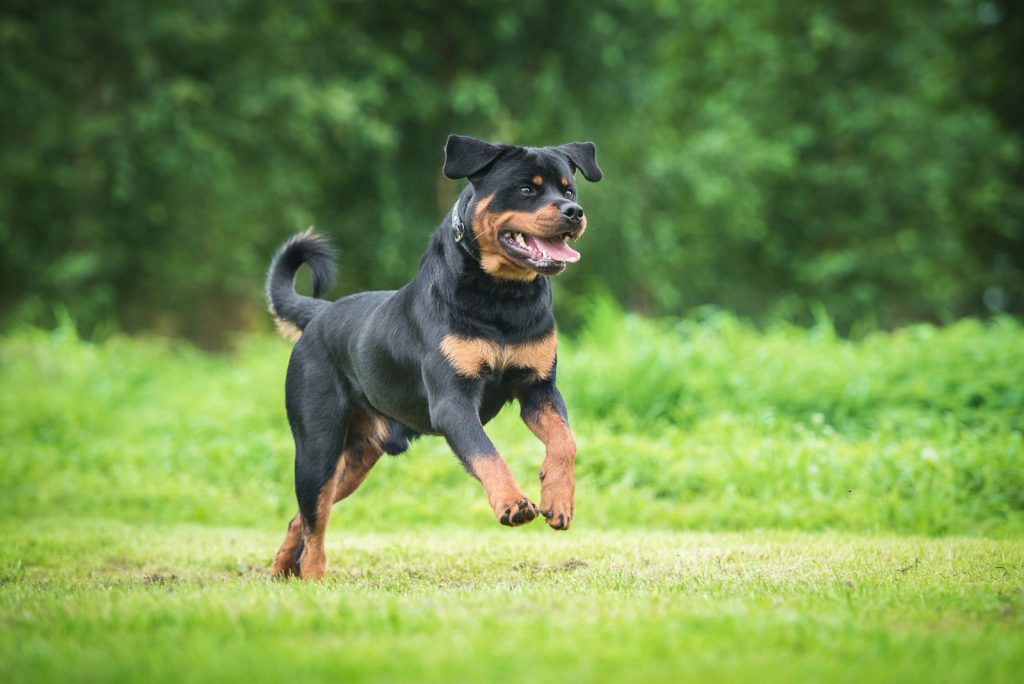
A Rottweiler is a very versatile dog. It excels at both working and as a family dog but requires focused physical activity to maintain strength and spend its energy. Since it is muscular and large, the breed has moderate energy levels.
Trainability is high, but early obedience training is mandatory for good behavior and the establishment of a pecking order. This is not a good dog for first-time owners, as they are known for their dominance.
Mostly used as protection and service dogs, the Rottweiler is highly alert and not fond of strangers. Although their temperament is not known for patience, they are moderately tolerant of small children. Early exposure to children is a viable fix.
Needless to say, its watchdog instincts are high, and a Rottie will rise to the occasion for any potentially dangerous scenario. That does not impede its affection or loyalty towards the family, so occasional cuddles are welcomed.
The breed is not a big barker but is very perceptive as to when a vocal display is necessary. Brave and bold, the Rottweiler dog is the perfect defender against intruders, having the strength to tackle any obstacle in front of it.
For a serious, protective dog, it is surprisingly playful. Owners will enjoy playing any kind of game with a Rottweiler and cherish the odd moment of silliness.
A house with a large yard will always be better for this dog breed, but it will adapt easily to any environment, including apartments.
Socialization
Exposing your Rottie to situations that are a common occurrence in your daily life will help reduce the chance of unwanted behavior. Dog parks can get messy when a strong, dominant dog enters without being socialized prior to it.
Living with other dogs is not a Rottweiler thing, but if it was still a puppy when you got it, the Rottie would fit in perfectly. It is important for the dog to know who the leader of the pack is, so a firm but not intimidating approach is your best bet.
Their prey drive is low, and your small pets are going to test their luck by playing with it. If your dog is obedient and taught to behave around smaller animals, there should be no problems.
According to breed club standards, the Rottweiler is allowed to be aggressive but in a domineering aspect. Attacking behavior is not a natural state of mind for a Rottweiler that is properly socialized. Big dogs are self-assured, so they will act dominant when people or animals are timid or shy.
Similarly, a shy Rottweiler is considered to have an unwanted temperament. This can happen when a puppy Rottie does not follow a desensitization program such as Early Neurological Stimulation (ENS).
We wrote an article dealing with the question of whether Rottweilers are a dangerous dog breed, so if your Rottweiler curiosity is giving you an intense itch, scratch this short piece.
Diets, Health Issues, And Life Expectancy In Red Rottweilers
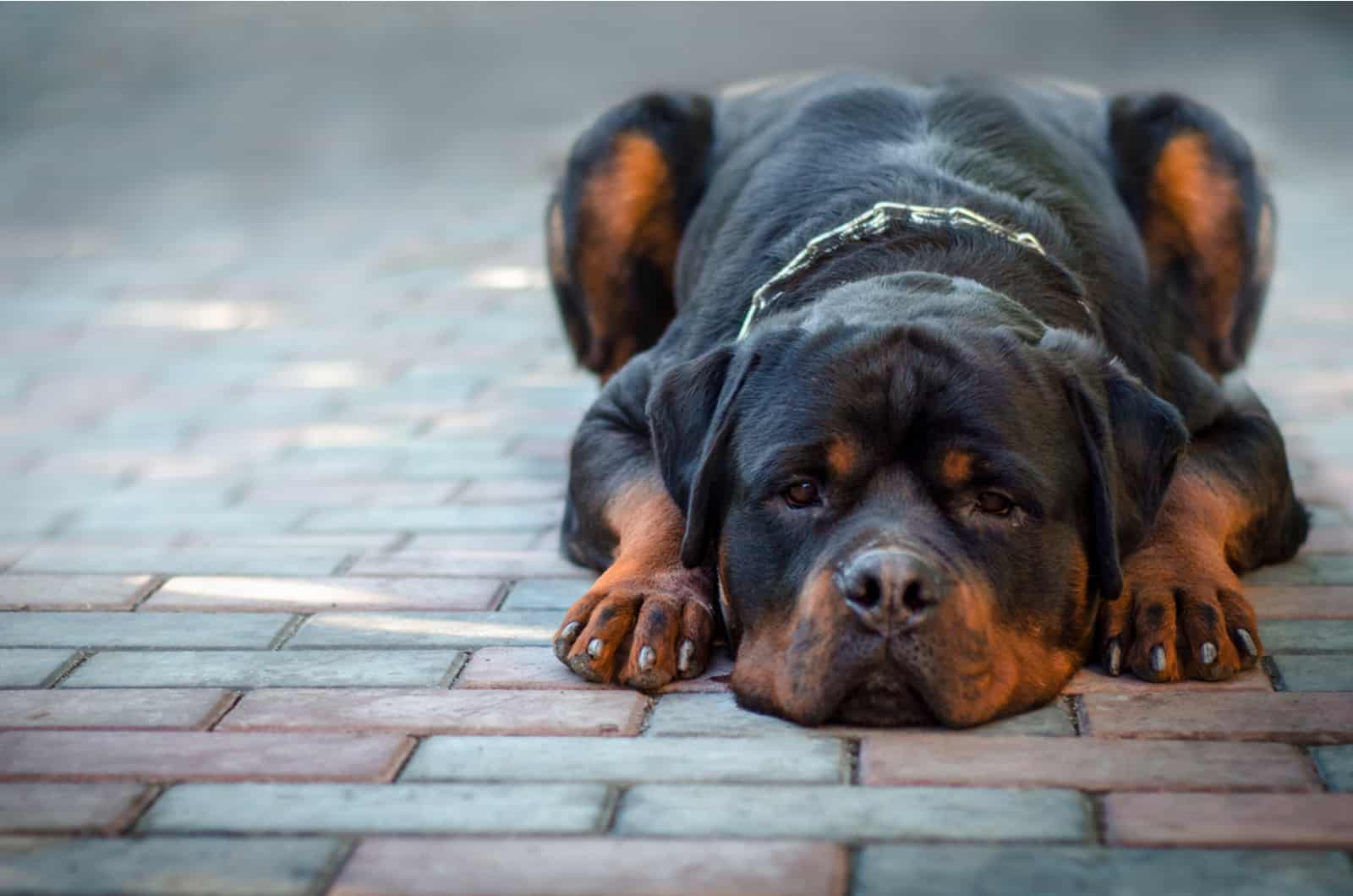
A red Rottweiler is more likely to have congenital diseases such as hip dysplasia, elbow dysplasia, entropion, aortic stenosis, etc. Rottweilers of standard colors are prone to many of the same conditions but not as often as those with genetic mutations.
Good eating habits and complete diets are key to reducing the chance of developing health conditions. Even with red Rottweilers, where genetics predispose them to hereditary health issues, keeping general health on a high level can help the dog have a better quality of life.
Diets And Obesity
One of the leading problems in dogs, especially with heavy musculature such as a Rottweiler, is obesity. An overweight dog will be more prone to developing secondary diseases such as diabetes or hypothyroidism due to hormonal disbalance.
Dog food choice plays the main role in lowering the likelihood of damaging the metabolism and immune system, so high-quality commercial or home-cooked food is not something you want to debate if you own a Rottweiler.
Rottweiler raw diets are great for experienced owners, but first-time dog owners should stick to the easiest, most quality-oriented feeding regimes available to them. A developing puppy requires special attention in terms of protein, fat, and carbs ratio, so make sure you research this topic.
Giving treats to your dog should be limited and controlled. Just because this type of food is not a full meal does not mean the calories it has should not be counted towards the daily limit. Have a look at our Rottweiler growth chart as a guideline for good development.
In case you are adamant that a Rottweiler is the dog breed for you, but you do not know much about foods and diet, we got you covered with a list of the best dog foods for a Rottweiler.
Hip And Elbow Dysplasia
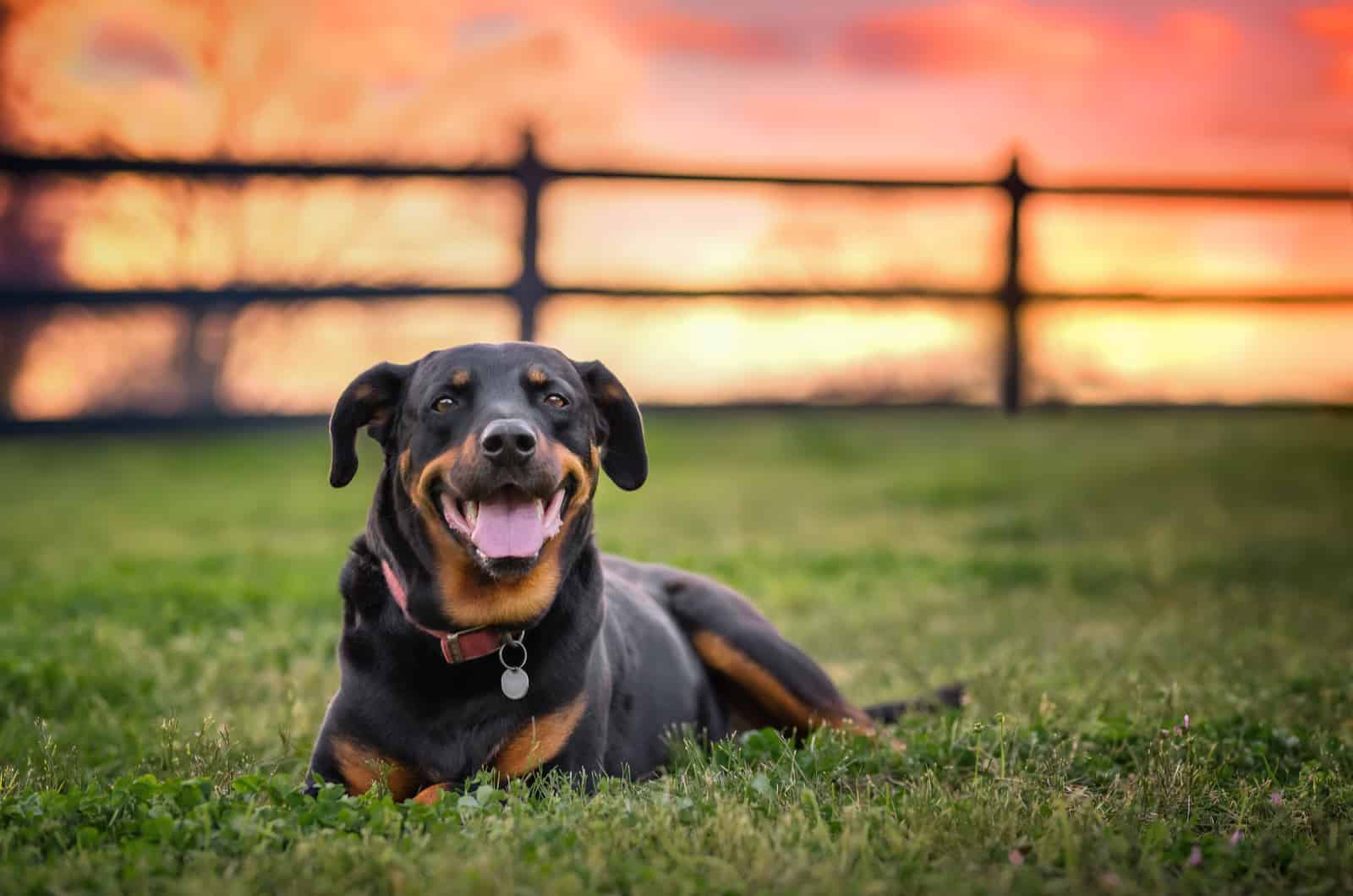
A common occurrence in the dog world, dysplasia of either joint is particularly present in breeds that are heavy. Despite the thick bones of a Rottweiler, dysplasia can cause major problems in movement.
While your red Rottie is still a puppy, the socket and ball of the elbow and hip joints will not fully mature. This anatomical abnormality leads to the tearing of the cartilage, which facilitates smooth movement of the joint.
Once the bones come into contact, the tissues erode over time, causing pain and difficulty moving. Physical activity increases pain and causes further damage, leading to surgery in severe cases.
Milder cases can be managed with NSAIDs, but ultimately, your Rottweiler will develop osteoarthritis. Though there is no treatment for arthritis, secondary care and lifestyle changes are effective at reducing pain and inflammation, providing a decent quality of life for your dog.
Entropion
This condition causes the third eyelid in Rottweilers to fold over itself, growing inward and causing the eyelashes and hair around the eye to irritate the cornea. The condition itself is mostly congenital but can be caused by injury or underlying health problems.
If left untreated, corneal ulcers, pigmentation of the eye, and pain will damage the dog’s vision. Due to the genetics of the dog breed, Rottweilers are more prone to it than other dogs. Red Rotties have an even higher likelihood of entropion.
The treatment includes a routine surgery that will reattach the third eyelid properly, and therapy of antibiotics and NSAIDs can help prevent infection and decrease pain. If you notice swelling, redness, or discharge from your Rotweiller’s eye, visit the vet.
Aortic Stenosis
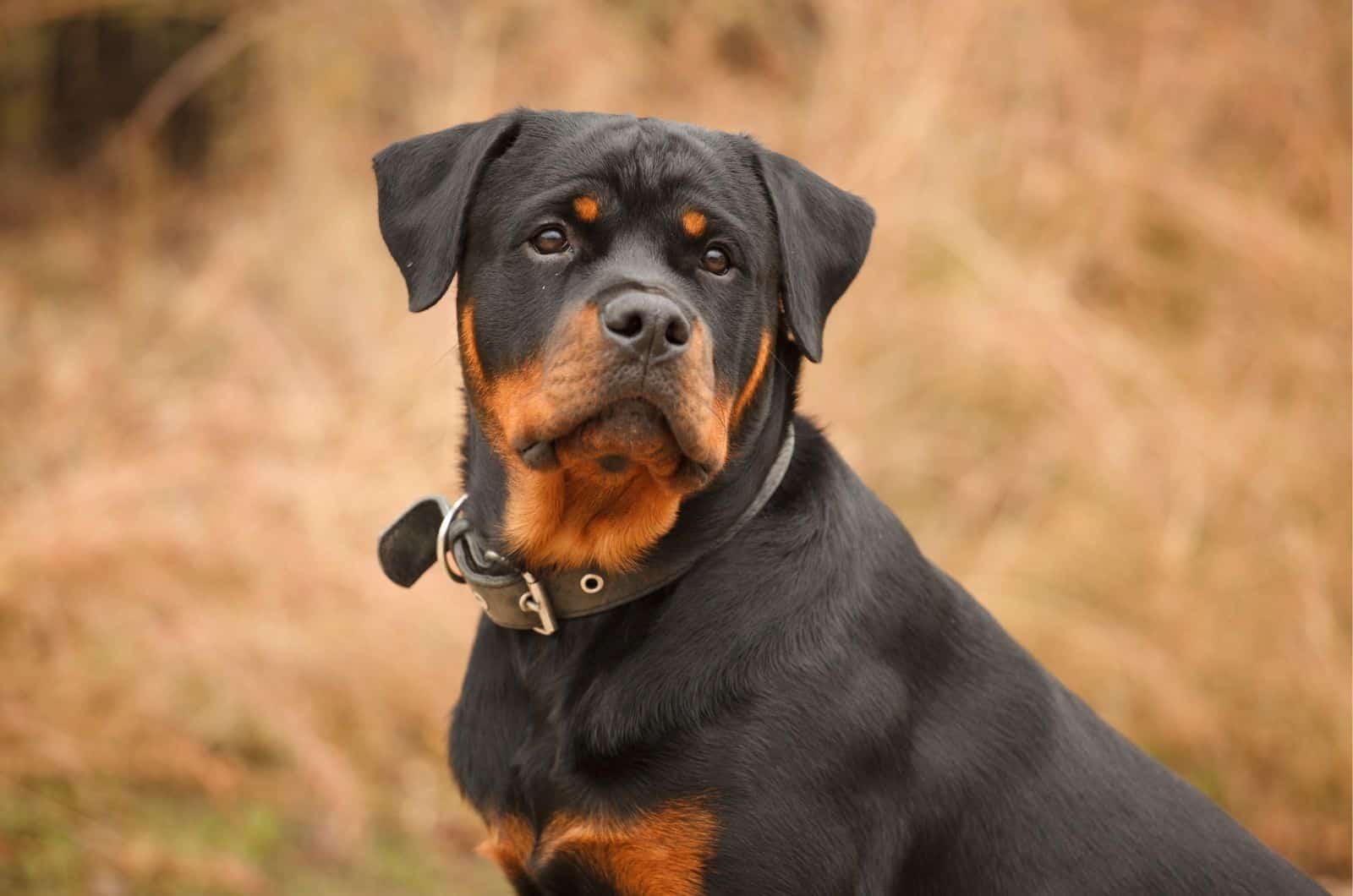
Large breed dogs such as the Rottweiler frequently suffer from aortic stenosis. The type that is most commonly diagnosed in dogs is subaortic stenosis. Nodules made out of fibrous tissue form on the left ventricular outflow tract, reducing the left aortic output.
With an impeded ability to properly distribute blood throughout the body, the heart will work at a reduced capacity. This means that the symptoms will include exercise intolerance, lethargy, heart murmur, or syncope.
In some cases that are asymptomatic, the condition can cause sudden death. For this reason, regular vet checkups that include an echocardiogram can point to aortic stenosis. These irregularities can warrant a full body analysis for a decisive diagnosis.
Treatment includes medication, surgery, or balloon valvuloplasty. Therapy is dependent on the severity of the condition. If noticed early, medication can help cope with the symptoms, but surgery or balloon valvuloplasty is a long-term solution.
Osteochondritis Dissecans
Though the symptoms may coincide with elbow or hip dysplasia, OCD is quite different from the anatomical perspective. Cartilage is the cushion between bones that helps avoid friction and damage.
For an unknown reason, large dog breeds can develop inflammation in the area where the affected cartilage tissue separates from the adjacent bone. Shoulders are the most affected part of the body, but other joints cannot be excluded as a possibility.
Symptoms are usually movement-related, so your dog might limp, have trouble lying or sitting down, accompanied by pain when touching the problematic joint.
Treating this condition is hard because it requires complete rest for milder cases but surgery for more severe cases where the cartilage is completely detached from the bone.
Lymphoma
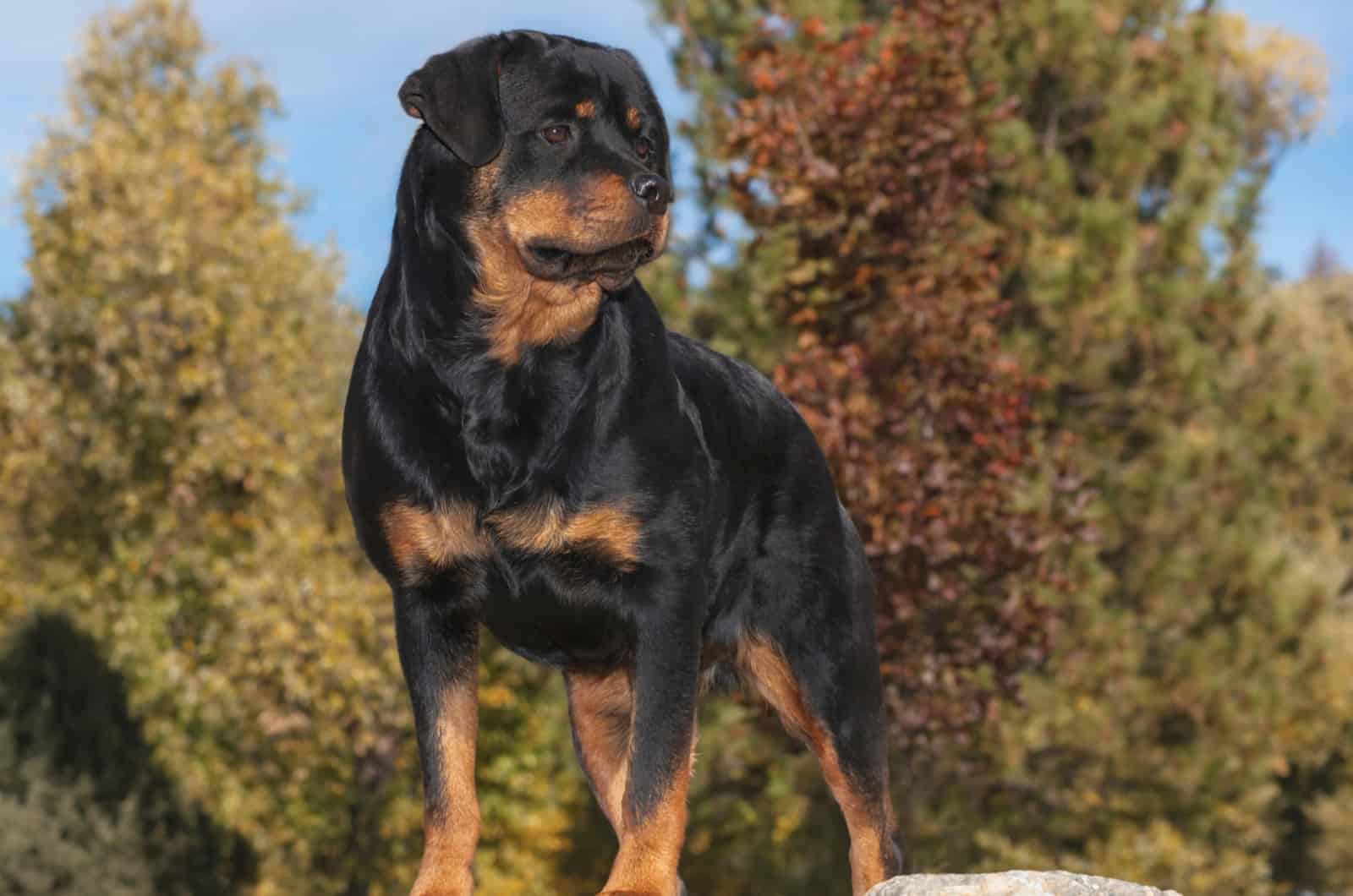
Cancer is among the top causes of Rottweiler deaths in the US. Specifically, multicentric lymphoma is behind eighty to eighty-five percent of cancer-related deaths in dogs.
As the name says, lymphoma is a type of cancer that originates in the lymphocytes (white blood cells). Since they are an integral part of the immune system, it is clear their effect is devastating to the body.
Multicentric means that multiple lymph nodes are affected at the same time, leading to system-wide lymph node enlargement. The swollen masses can be diagnosed with a palpation test, but other symptoms include dehydration, lethargy, anorexia, or a general lack of energy.
A chemotherapy protocol UW-25 is a variation of the CHOP protocol administered in cases of human cancer, and its effectiveness has been proven to give a positive prognosis in most cases. For other types of cancer, different treatment options will be recommended.
Life Expectancy
Taking into consideration all of the health issues and a proper diet, Rottweilers live between nine and ten years. Large dog breeds usually do not have an overly long lifespan due to their genetic makeup, but also rather active lifestyle.
It is possible for Rottweilers to live longer than ten years, but those cases are very individualistic and depend on breeder choice. Rottweiler breeders should always have a full pedigree, health screening records of the parents, and papers confirming a clear bill of genetic health.
No one can guarantee that some genetic conditions will not occur, as several of those develop in the later years of a dog’s life, but most good breeders will give a one or two-year health guarantee that covers the most important hereditary diseases.
The American Kennel Club Rottweiler Breed Standards
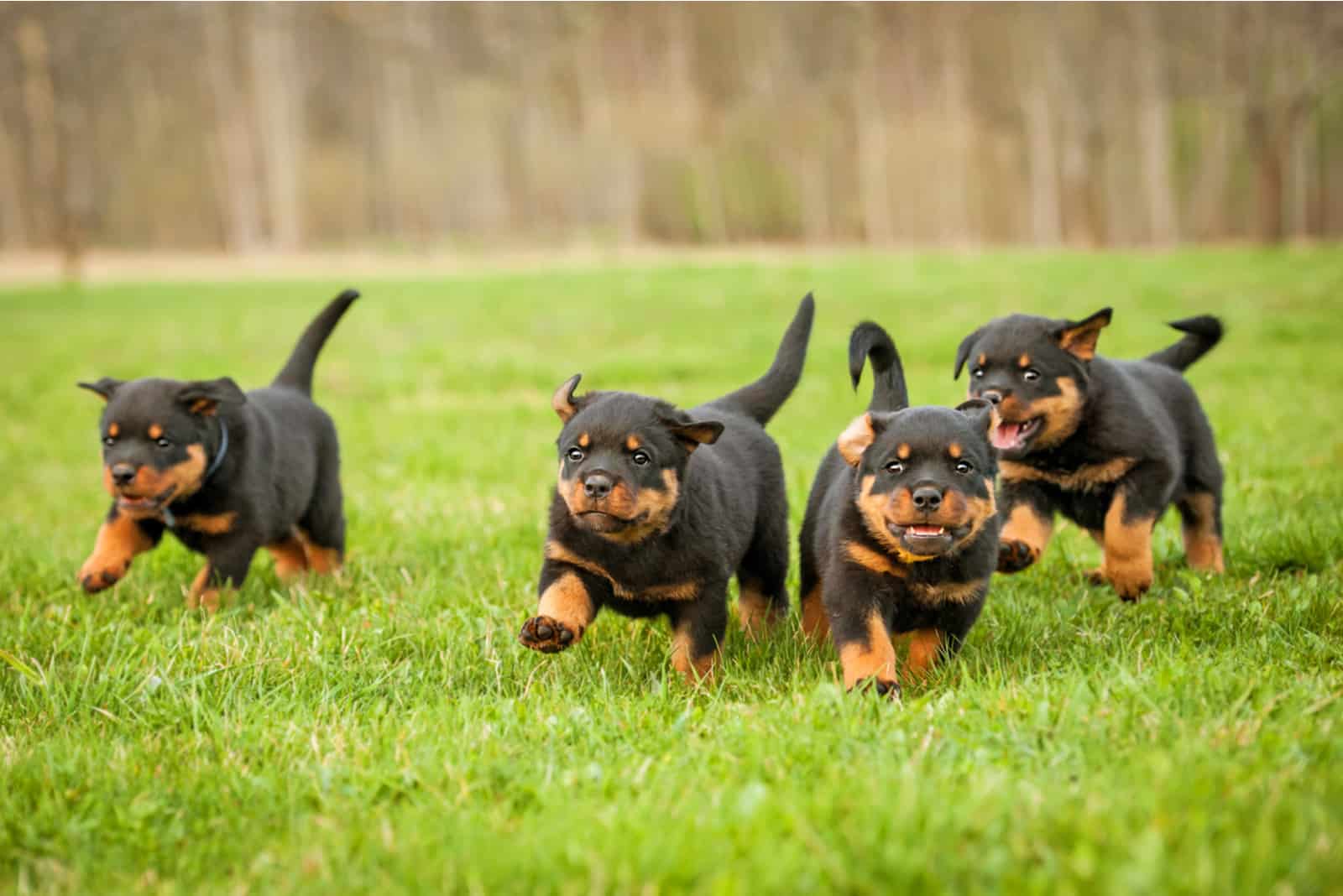
Purebred Rottweilers have well-defined AKC breed standards that require specific colors and markings for your dog to be considered a purebred Rottie. Any deviation from this set of specifications is a reason for disqualification.
Tan, mahogany, or rust markings on the chest, eyebrows, the lower part of the legs, neck, and lower jaw with a black main color are breed standard. All the markings must be clearly delineated from the rest of the main coat color (black).
White markings, other main coat colors, or hazy lines between markings and main coat colors are reasons for disqualification. The markings should be present on both the front and rear legs, from the elbow to the feet, but slightly higher than the elbow on the inner side.
The inner part of the hips also has to spill onto the lower legs, with the outside leg having slightly less visible markings. Two tan, mahogany, or rust spots placed exactly over the eyes, paired with lower jaw coloration that seamlessly connects with the neck and upper chest markings, is a must.
If a Rottweiler does not have black pigmentation on the toes and markings on the tail side facing the ground, it will be disqualified. In addition to coat color standards, there are other physical and temperamental traits a purebred Rottweiler must have, so let us talk about them.
Conclusion
Getting dog breed information can be time-consuming and unproductive at times. For this reason, I like getting straight to the point, so let me tell you that a red Rottweiler is something you want to avoid.
No matter how much you like the color and breed combination, you are better off getting a rescue or purebred Rottweiler that is of a standard color but in top health and mental condition.
Investing into a dog that is either falsely represented as a purebred Rottweiler but is instead a mixed breed that looks similar is not a good choice. Investing in a red Rottweiler is even worse because the color is a clear sign of genetic mutations.
The prospect of having the most unique dog can work against you in this case, so going the recommended, proven route is the best advice I can give. Avoid backyard breeders and shady deals that offer everything except transparency and documentation.
Most of all, do your own research regarding the breed and particular type of dog within it before deciding. Rushing into getting a dog based purely on its coat color will be a bad decision in the long run. Stay sharp, stay informed, and love your dog.
